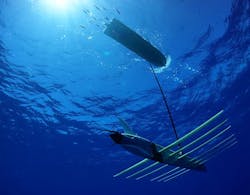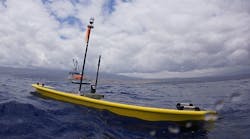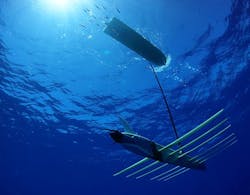Coast Guard looks for unmanned ocean vehicles to hunt smugglers, poachers, and icebergs
Officials of the Coast Guard Research and Development Center in New London, Conn., last week issued a sources-sought notice (HSCG32-14-I-R00012) for the Coast Guard Persistent Unmanned Marine Vehicle Market Research program.
This action is to survey industry for ready-to-deploy long-endurance unmanned oceangoing craft such as unmanned surface vehicles (USVs), unmanned underwater vehicles (UUVs), or hybrid unmanned vehicles like sea gliders to handle Coast Guard surveillance missions offshore.
Coast Guard officials are looking for long-endurance marine vehicles that can operate unattended -- except for remote monitoring -- for several weeks to several months.
Several of these kinds of vehicles are available today. There are wave-powered unmanned surface vehicles that look like a floating surfboard that dangle a weighted system underneath that propels the craft forward as wave action flaps underwater wings.
(story continues below)
This kind of unmanned vehicle can have solar panels or small wind turbines on top. It has extreme endurance, but moves very slowly.
Another option would be a sea glider, which propels itself forward with wings and stabilizers as it slowly sinks deeper in the ocean. this craft also has extreme endurance, but spends only limited time at the surface. Unmanned submersibles could be an option. They can cover areas relatively quickly, but their endurance might be questionable.
Related: DARPA considers unmanned submersible mothership designed to deploy UAVs and UUVs
Unmanned marine vehicle suppliers include Liquid Robotics Inc. in Sunnyvale, Calif.; SeeByte Ltd. in San Diego; SeaRobotics Corp. in Palm Beach Gardens, Fla.; ASV Global in Portchester England; Teledyne Benthos Inc. in Fall River, Mass.; Exocetus Development LLC in Anchorage, Alaska; General Dynamics Robotic Systems (GDRS) in Westminster, Md.; Hydroid Inc. in Pocasset, Mass.; Bluefin Robotics Corp. in Quincy, Mass.; and Kongsberg Maritime AS in Kongsberg, Norway.
These unattended oceangoing vehicles must be able to detect the presence of a target like drug smugglers, human traffickers, or illegal fishermen, classify them, and report their locations, courses, speeds, and levels of certainty, and report this information to Coast Guard command centers.
Officials are trying to determine if rugged commercial-off-the-shelf (R-COTS) and government-off-the-shelf (GOTS) persistent-surveillance UMVs, as well as related sensors, data processing, communications, and monitoring packages are available on the open market.
Related: Liquid Robotics Wave Glider battles Hurricane Isaac
An example of how persistent UMV technology might support Coast Guard missions is the establishment of a picket line to detect the transit of potential human traffickers or drug smugglers; the entry of vessels into a regulated area like a national marine sanctuary; fishing operations in a closed area; or the presence of icebergs, Coast Guard officials explain.
The UMV system (which might include an operations center ashore) would detect the presence of a target, classify it as a target of interest, and report the current location, course, speed and level of certainty for relay to a Coast Guard command center.
From industry, the Coast Guard wants UMV specifications, sensor and communications capabilities, reliability data, costs, operational practices, operational limitations, and sense-and-avoid capabilities. Officials caution that this is an industry survey and not a formal solicitation.
Companies interested should email responses no later than 2 May 2014 to [email protected]. Email questions or concerns to [email protected].
More information is online at https://www.fbo.gov/spg/DHS/USCG/USCGRDC/HSCG32-14-I-R00012/listing.html.


